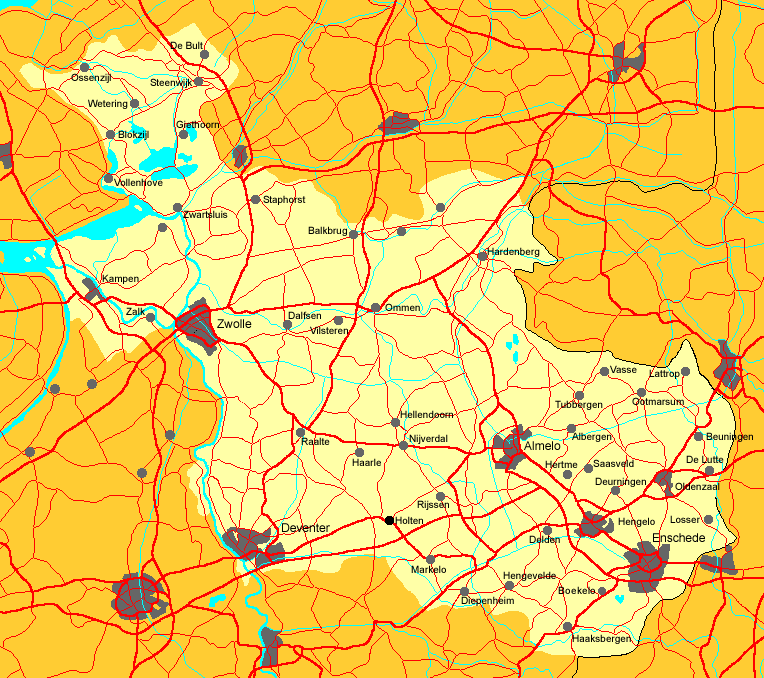Overijssel was, in ancient times, along with Drenthe, the Gorecht (is today a part of Groningen) and the Stellingwerven (now a part of Frisia) a “colony” of the diocese of Utrecht. The province lies, seen from Utrecht, on the other side of the river “Gelderse IJssel”, so “over the IJssel”, which explains the name. It was divided in: Steenwijkerland (Stienwiekerlaand), Salland (Sallaand) and Twente (Tweante). It should be noted that the name “Twente” has an ancient form of “two” hidden in the name. An old division into four quarters is still a bit visible.
The province of Overijssel
The province borders in the northwest to Friesland, in the north to Drenthe, in the north-east and east to Germany, in the south to Gelderland and to Flevoland in the west.
The capital is Zwolle. The population density is 342 inh. / Km2.
The arm of coat is similar to that of (Southern) Holland but is additionally intersected with a wavy blue line that reminds the river IJssel (the old border to Gelderland). The flag is the same as the old flag of South Holland but is also intersected by the blue wavy line. (Today South-Holland uses again the old historic lionflag of ancient Holland, as flag for that province!).
Provincial broadcast: (Radio-Oost) & (TV-Oost) & (Teletext).
Overijssel in a birds eye & Weather in Overijssel & Weather warnings in Overijssel.
Overijsselian government. & Houses of Overijsselian “states” (parliament) (photo’s).
Tourisme in Overijssel.
Anthem of Overijssel (Dutch)
Dutch English
-1- -1-
Aan de rand van Hollands gouwen, At the borders of Hollands shires,
Over brede IJsselstroom. Across the wide IJssel River.
Ligt daar, lieflijk om t’aanschouwen, There lies, lovely to behold,
Overijssel, fier en vroom. Overijssel, proud and brave.
-2- -2-
Waar de Vecht en Regge kronk’len, Where Vecht and Regge squirm,
Door de heuv’len in ‘t verschiet. Through the hills on the horizon
Waar de Dinkelgolfjes flonk’len, Where Dinkel Wavelets flonkelen,
Ligt het land dat ‘k still bespied. Lays the land that I watch in silence.
-3- -3-
‘k Heb U lief: G’omvat in glorie, I do love You, You covered by glory,
Oudheid, Kunst en Klederdracht. Antiquity, Art and Costume.
Eertijds streden om victorie, In old days competed for victory,
Steden — Ridders, burchtenmacht. Cities – Knights and fortresses.
-4- -4-
D’eindeloze twisten brachten, The endless quarrels brought,
U, mijn land, geen voorspoed aan. To You, my country, no prosperity.
Toch is uit Uw leed en klachten, Yet out of thy sorrows and complaints
Rijke stedenbloei onstaan. Rich and flourishing cities arose.
-5- -5-
Gij bidt God, dat Hij op ‘t zaaien While seeding you pray to God that
Rijpen doe ‘t gestrooide zaad; He lets ripening the sprinkled seeds
Dat Ge dankbaar ‘t graan moogt maaien, That you thankful the grain may mow,
Als het uur van oogsten slaat. When the hour of harvesting strikes.
-6- -6-
Oversticht, Uw schone weiden, Oversticht, your clean pastures,
Horizonten, paarse hei. Horizons, purple moors.
Boeien hart en ziele beide, Touches both heart and soul,
Van Uw volk, Gij zijt van mij. Of thy people, thou are mine.
History
According to Tacitus the Tubanti (the inhabitants of Overijssel) were at the year 1 AD the Germanic tribe in the region now called Overijssel. During the punitive expedition of Germanicus in the year 14 (in a neighboring area, now part of Germany) their brother tribe of the Marsi was attacked by Roman troops in revence to the disastrous Battle of Varus, five years earlier The Tubanti (with the Bructeri and the Usipeti) came to the rescue, but suffered a defeat. It is assumed that the Tubanti had at that time already established themselves in the current eastern Netherlands. (The name Tubantia is still in use, locally. The people of east Overijssel still call themselves Tubanten or in dialect: Tukkers).
A few centuries later the Romans fought Tubantia again. Inspired by the cruelty of the Roman Emperor Constantine the Great in his attack on the Bructeri (308) several Germanic tribes (including the Tubanti) decided to attack the Roman Empire, but they were defeated by Constantine. After that battle the tribes on the east borders of the present Netherlands formed a union and called themselves Saxonians (axe-carriers).
The (so the now culturally Saxon) Oversticht included: the land of Vollenhove, Salland Twente and Drenthe. Some places acquired already in medieval times city privileges ( Almelo, Delden, Deventer, Diepenheim, Enschede, Genemuiden, Goor, Gramsbergen, Hardenberg, Hasselt, Kampen, Oldenzaal, Ommen, Ootmarsum, Rijssen Steenwijk, Vollenhove, Wilsum and Zwolle).
In 1528 the bishop of Utrecht lost the Sticht (Utrecht) and the Oversticht to the Emperor Charles V. This emperor became so beside an emperor, also the lord of Overijssel. So the name county Overijssel came into use. This lasted only briefly because the states of Overijssel decided to join the United Provinces. These “States of Overijssel” were formed by the Hanseatic cities of Deventer, Kampen and Zwolle and the knighthoods of Salland Twente and Vollenhove. In Kampen and Zwolle the first “Compagnie van Verre” (= Compagny to go far away) was founded for the trade on (mainly) Poland.
Since the revolt against Philip II (the beginning of the 80-years war for freedom) Overijssel was part of the Republic of the Seven United Netherlands. It was ruled by the mayors of the major cities and members of the knighthood. The stadhouders were given more influence after a brief occupation (1672-1674) by the Germans (the bishop of Munster). At the formation of the Batavian Republic (1795), Overijssel formed along with parts of Gelderland, Drenthe and Friesland, the Department of the Old IJssel. But the old provincial boundaries were restored around 1815.
Han Tiggelaar


